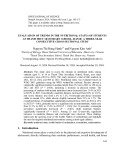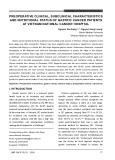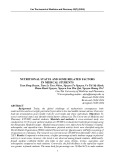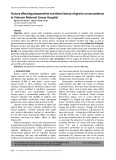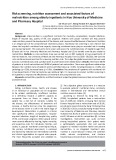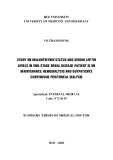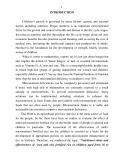
Malnutrition status
-
This study aims to assess the changes in nutritional status among students aged 11 to 14 at Thanh Thuy Secondary School, Hanoi, over three consecutive years (2021 to 2023). The study involved a total of 606 students in 2021, 638 in 2022, and 694 in 2023.
 11p
11p  viaburame
viaburame
 14-03-2025
14-03-2025
 3
3
 1
1
 Download
Download
-
Gastric cancer ranked fourth for incidence and mortality of all cancers in Vietnam. Clinical symptoms in the early stages are often nonspecific. Patients may have epigastric pain, anorexia or weight loss. Gastroscopy combined with biopsy is a clinical test that helps diagnose gastric cancer.
 10p
10p  viyamanaka
viyamanaka
 06-02-2025
06-02-2025
 3
3
 2
2
 Download
Download
-
Today, the global challenge of malnutrition encompasses both undernutrition and overweight, particularly prevalent in low and middle-income nations. Excessive body fat accumulation poses health risks for overweight and obese individuals. Objectives: To assess nutritional status and identify related factors among Can Tho University of Medicine and Pharmacy (CTUMP) medical students.
 7p
7p  vinara
vinara
 11-01-2025
11-01-2025
 2
2
 1
1
 Download
Download
-
Gastric cancer (GC) sometimes presents as asymptomatic or exhibits only nonspecific symptoms in its initial stages, resulting in delayed diagnosis and subsequent starvation. Patients with gastric cancer who had preoperative malnutrition faced a heightened risk of unfavorable clinical outcomes.
 7p
7p  vihatake
vihatake
 06-01-2025
06-01-2025
 6
6
 2
2
 Download
Download
-
This study aims (1) to screen and assess the nutritional status of inpatients aged from 60 years old in Hue University Medicine and Pharmacy Hospital and (2) to identify some factors related to malnutrition.
 9p
9p  viharuno
viharuno
 03-01-2025
03-01-2025
 3
3
 2
2
 Download
Download
-
To investigate of nutritional status in maintenance hemodialysis patients by indicators: anthropometric, dietary energy, and protein intake, dialysis malnutrition score, serum albumin, prealbumin levels. To Understand the relationship between nutritional status and some clinical and laboratory characteristics, initially assessing the results of an oral nutritional supplement on nutritional status in 12 weeks in maintenance hemodialysis patients.
 24p
24p  angicungduoc6
angicungduoc6
 21-07-2020
21-07-2020
 25
25
 3
3
 Download
Download
-
To investigate of malnutrition by using indicators: SGA_3, Body Mass Index, serum prealbumin, serum albumin, normalized protein catabolic rate (nPCR) and serum leptin concentration in patients with chronic kidney disease are on Hemodialysis and continuous peritoneal dialysis at Can Tho General Hospital. To find the factor related malnutrition, serum leptin levels and clinical, subclinical, and all-cause mortality in 12 months in these two patient groups.
 27p
27p  cothumenhmong6
cothumenhmong6
 17-07-2020
17-07-2020
 29
29
 1
1
 Download
Download
-
Therefore, we conducted the topic: "Nutritional status and effectiveness of iron and zinc fortified rice in children aged from 36 to 2 under 60 months in Vu Thu district, Thai Binh province" with the following objectives: To determine the rate of malnutrition, the prevalence of anemia, in children aged from 36 to under 60 months and some related factors in Vu Thu district, Thai Binh province. To analyzie characteristics of diets and prevalence of iron and zinc deficiency in children aged from 36 to under 60 months;
 24p
24p  cotithanh321
cotithanh321
 06-08-2019
06-08-2019
 21
21
 2
2
 Download
Download
CHỦ ĐỀ BẠN MUỐN TÌM








